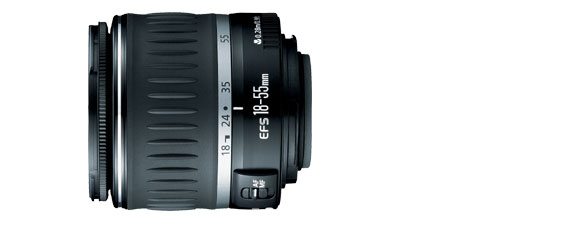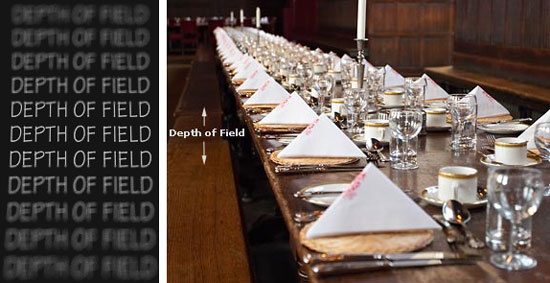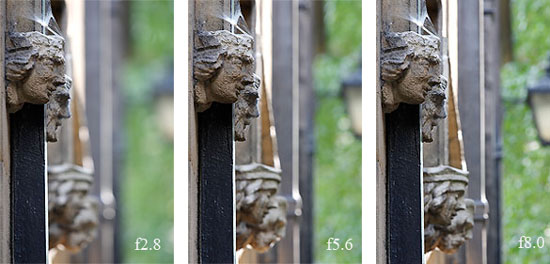Digital Photography from 20,000 Feet
by Wesley Fink on September 25, 2006 12:05 AM EST- Posted in
- Digital Camera
F Stop: The Speed of the Lens
Most buyers today are used to the idea of zoom lenses, and they aren't even aware of how many compromises the common "kit" zoom lens forces on them. The biggest compromise by far is lens speed. Film SLR cameras normally came with a normal lens that was rated at an f-stop of f1.7-1.8, where most zoom lenses are rated at speeds like f3.5-f5.6. What is F-Stop, anyway?
F-stop is the focal length divided by the diameter of the lens. For example, a 200mm f/4 lens will be 50mm wide. 200mm/50mm = f/4. That is why f-stop is typically written as F/4, meaning "focal-length over 4" or "focal-length divided by four".

The aperture scale is like the ISO film speed scale in reverse. Each full F-Stop is half the light of the earlier number, and the LOWER the number the more light the lens can pass. Lenses are marked with a range of f-stops. The maximum light-gathering ability of a lens is determined by the lowest number or f-stop, and the rest of the range is adjustments to reduce amount of light the lens will pass. Look at the f-stop scale:
1 - 1.4 - 2 - 2.8 - 4 - 5.6 - 8 - 11 - 16 - 22 - 32
The progression of f-stops are powers of the square root of 2. This means each number, as it increases in full f-stops, will pass half the light of the previous smaller number.

Let's return to yesterday's typical normal lens at f1.7 and today's standard zoom at f3.5-f5.6. F1.7 to 1.8 is a half f-stop, which is 1.5 times faster than f2.0, and f3.5 is a half f-stop between 2.8 and 4.0. So, under the best circumstances, the f1.7 lens is capable of passing FOUR times the light of the zoom lens. This is under the best circumstances, however, since the f5.6 is the other end of a variable aperture. At the f5.6 end, the f1.7 can pass TWELVE times the amount of light of the f1.7. So if we have a zoom lens that is rated 18-55mm f3.5-5.6, it is capable of passing ¼ the light of the f1.7 at the 18mm side, and 1/12 the amount of light of the f1.7 at the 55mm end of the zoom range. In between the amount varies smoothly from 1/4 to 1/12.
Buyers who wonder why they have trouble taking sharp indoor photos with a standard zoom now have their answer. You will have to crank up the ISO, turn on anti-shake if it's an option, or use a flash to supplement light if you plan to take the typical family indoor photos with a standard zoom lens. Or you could buy a normal lens while there are still some on the market and attach a lens that was designed to shoot images in available light.
Depth of Field
Fast lenses are great, in that they allow you to shoot in lower light than a slower lens. However, there is a price to pay for this low-light capability. All things being equal the faster the lens the shallower the depth of field. What do we mean by depth of field?

Depth of field is the amount of distance between the nearest and farthest objects that appear in acceptably sharp focus in a photograph. A "good" depth-of field is pretty subjective, since a shallow depth of field might be preferred in a portrait of your girlfriend, but a wide depth of field is preferred in landscape shots. A few factors affect depth of field; they are:
1) the diaphragm opening of the lens (the aperture or f-stop),
2) the focal length of the lens in use, and
3) image size (which has a direct relationship to distance from the subject).

The general rule of thumb is the bigger the lens opening (aperture) used (the smaller the f-stop) the more shallow the depth of field.
This means that critical focusing will be required with a large f-stop because when you use a large aperture - in particular when attempting to focus at a nearby subject - the zone of sharpness (DOF) can be very limiting. On the other hand, if extended depth of field is desired, you can just choose a smaller lens opening (larger f-stop like f/8, f/11, f/16, f/22) to extend the plane of sharpness, so everything will be in sharper focus.
Depth of field also increases with distance. This means the farther you place the camera from your subject, the greater the depth of field. Landscapes have great depth of field, while macro (close-up) photographs tend to have very little depth of field because the subject is so close to the lens.
Most buyers today are used to the idea of zoom lenses, and they aren't even aware of how many compromises the common "kit" zoom lens forces on them. The biggest compromise by far is lens speed. Film SLR cameras normally came with a normal lens that was rated at an f-stop of f1.7-1.8, where most zoom lenses are rated at speeds like f3.5-f5.6. What is F-Stop, anyway?
F-stop is the focal length divided by the diameter of the lens. For example, a 200mm f/4 lens will be 50mm wide. 200mm/50mm = f/4. That is why f-stop is typically written as F/4, meaning "focal-length over 4" or "focal-length divided by four".

The aperture scale is like the ISO film speed scale in reverse. Each full F-Stop is half the light of the earlier number, and the LOWER the number the more light the lens can pass. Lenses are marked with a range of f-stops. The maximum light-gathering ability of a lens is determined by the lowest number or f-stop, and the rest of the range is adjustments to reduce amount of light the lens will pass. Look at the f-stop scale:
1 - 1.4 - 2 - 2.8 - 4 - 5.6 - 8 - 11 - 16 - 22 - 32
The progression of f-stops are powers of the square root of 2. This means each number, as it increases in full f-stops, will pass half the light of the previous smaller number.

Let's return to yesterday's typical normal lens at f1.7 and today's standard zoom at f3.5-f5.6. F1.7 to 1.8 is a half f-stop, which is 1.5 times faster than f2.0, and f3.5 is a half f-stop between 2.8 and 4.0. So, under the best circumstances, the f1.7 lens is capable of passing FOUR times the light of the zoom lens. This is under the best circumstances, however, since the f5.6 is the other end of a variable aperture. At the f5.6 end, the f1.7 can pass TWELVE times the amount of light of the f1.7. So if we have a zoom lens that is rated 18-55mm f3.5-5.6, it is capable of passing ¼ the light of the f1.7 at the 18mm side, and 1/12 the amount of light of the f1.7 at the 55mm end of the zoom range. In between the amount varies smoothly from 1/4 to 1/12.
Buyers who wonder why they have trouble taking sharp indoor photos with a standard zoom now have their answer. You will have to crank up the ISO, turn on anti-shake if it's an option, or use a flash to supplement light if you plan to take the typical family indoor photos with a standard zoom lens. Or you could buy a normal lens while there are still some on the market and attach a lens that was designed to shoot images in available light.
Depth of Field
Fast lenses are great, in that they allow you to shoot in lower light than a slower lens. However, there is a price to pay for this low-light capability. All things being equal the faster the lens the shallower the depth of field. What do we mean by depth of field?

Depth of field is the amount of distance between the nearest and farthest objects that appear in acceptably sharp focus in a photograph. A "good" depth-of field is pretty subjective, since a shallow depth of field might be preferred in a portrait of your girlfriend, but a wide depth of field is preferred in landscape shots. A few factors affect depth of field; they are:
1) the diaphragm opening of the lens (the aperture or f-stop),
2) the focal length of the lens in use, and
3) image size (which has a direct relationship to distance from the subject).

The general rule of thumb is the bigger the lens opening (aperture) used (the smaller the f-stop) the more shallow the depth of field.
This means that critical focusing will be required with a large f-stop because when you use a large aperture - in particular when attempting to focus at a nearby subject - the zone of sharpness (DOF) can be very limiting. On the other hand, if extended depth of field is desired, you can just choose a smaller lens opening (larger f-stop like f/8, f/11, f/16, f/22) to extend the plane of sharpness, so everything will be in sharper focus.
Depth of field also increases with distance. This means the farther you place the camera from your subject, the greater the depth of field. Landscapes have great depth of field, while macro (close-up) photographs tend to have very little depth of field because the subject is so close to the lens.










81 Comments
View All Comments
wheel - Tuesday, September 26, 2006 - link
Thanks for your reply.Regarding the Canon 50mm 1.8, I think most people would agree that the 1.4 is better since it has full time manual focus and also a silent USM motor, plus 8 aperture blades instead of 5 for nicer, smoother looking bokeh (out of focus areas in an image). Of course when you consider the cost differential most people choose the f1.8 and for many it is the smarter choice! However I still believe your sentence in the article suggesting that it happens to be the sharpest lens in the lineup a little misleading. Not a big deal I guess.
If I can make some comments on the following paragraph:
There are plenty of Digital Camera Review sites out on the web, so you may ask why AnandTech is re-launching a Digital Photography section. It appears that current sites are rarely on target with what computer enthusiasts want to know about digital cameras. Some sites make the assumption that the reader knows a lot more about photography than our average reader, which often leads to much of the review being gibberish to a non-photographer. Other sites dwell on tests of things like "start-up times" that were important in early digital, but have become all but meaningless in today's digital SLR market. Still other sites, which are very well-grounded in traditional photography show an obvious lack of knowledge about computers and computer tools that make digital photography so flexible today. It is our sincere belief that we can do it in a better way for our readers and computer enthusiasts everywhere, but please help us as we try to reinvent this wheel. Some of our readers may not like AT delving into Digital Camera Reviews, and to them we say you just can't ignore digital photography any more. Today's digital imaging is nothing more than an optic stuck on a computer, and there is very little left of the mechanical gems that once ruled the world of photography.
A few points:
"Some sites make the assumption that the reader knows a lot more about photography than our average reader, which often leads to much of the review being gibberish to a non-photographer."
So a 'non-photographer' will find a technical review on the big digital camera sites gibberish? I don't think that is a problem, because such reviews aren't really aimed at non-photographers. I would guess that non-computer users are going to find articles on Anandtech about ram timings difficult to understand too!
Other sites dwell on tests of things like "start-up times" that were important in early digital, but have become all but meaningless in today's digital SLR market.
See my comments re: sports / action photography in my previous post. Start up times, shot to shot times and file flush times are quite important to me! Other sites have (very comprehensive) standardised tests that include these timings. I wouldn't say they dwell on the subject though, unless a particular camera is unusually bad at it. If it is not something that is relevant then a reader can easily skip it.
Still other sites, which are very well-grounded in traditional photography show an obvious lack of knowledge about computers and computer tools that make digital photography so flexible today.
In my years of reading the major photo review websites, I haven't encountered this. Without asking you to be specific, can you mention general examples of what you mean?
Cheers,
Ian
tagej - Tuesday, September 26, 2006 - link
The reality is that most computer geeks (myself included) are not photography experts, but are overall tech-savy and interested in things like digital SLR cameras.Sure, I can go to sites like dpreview and the like, and they do an excellent job of reviewing cameras from a pro or prosumer perspective. I could sit and read a bunch of stuff on those sites and educate myself to the point of becoming very knowledgable about cameras... Most of us don't want to do that, or we would have already done so. Instead, AT hit it right on the head with this article, it's a look at digital photograhpy for the tech savy who are not photography experts.
arswihart - Tuesday, September 26, 2006 - link
I totally agree with "wheel." If you feel the need to review cameras, go ahead, but thats not what I come to Anandtech for.aeternitas - Monday, September 25, 2006 - link
" The artistic types distrust turning their vision into cheap Adobe Photoshop tricks, and the tech-savvy are so enamored of technology and editing that they often don't have a clue about what makes a good photograph and what lens to use in a given situation. "I stopped reading there. If you want respectable people to respect you, its a good idea not to be a fucking jackass and insult the readers in the second paragraph. Get some common sence.
Resh - Tuesday, September 26, 2006 - link
Have to side with Wes on this one. Nothing in his words are offensive. He is simply stating the view point of two extremes of the population who both hold very valid positions.Wesley Fink - Monday, September 25, 2006 - link
These are comments from discussions I have had on Forums and in emails with readers. They were not meant to offend, but to point out the fact that the art and technical don't always mix well. This is particularly true when the market, and not the people affected, is forcing changes in the way people work.ksherman - Monday, September 25, 2006 - link
since we have had a camera review on AT! Kudos!To those that say no, I also like to read reviews from multiple sources. AT- dont try to be dpreview, make your reviews a little less technical, easier to understand. Not to fault them, but you need to have some pretty serious photography knolwedge to get their reviews. I would welcome an easier to understand set of reviews. (I do still enjoy reading about my level :-))
On another note, on the last page, you called canons new camera the Rebel XT1, its actually the XTi.
Also, take a gander at the Panasonic Lumix DMC-FZ50, its a sort of pre-digital SLR camera. It basically is a digital SLR, but with an attached lense. Its looking to be my next camera purchase since I am too poor to afford the "real" DSLRs.
saiku - Monday, September 25, 2006 - link
I am a hobbyist photographer (Canon 350D) who likes to do macros/scenery when I can. What I'd love to see are guides for people who want to get into DSLRs and don't know which camera system to buy into. For example, if a person is interested in macros, should he buy into a Nikon system? What about the guy who wants to shoot lots of indoor shots of his baby? Lens choices are very tough for newbies to make and a hefty dose of attention to what lens to pick would be great.PokerGuy - Monday, September 25, 2006 - link
Wes, thanks for the great article. I'm a grizzled vet when it comes to PC tech, but when it comes to photography I'm pretty much a noob. I appreciate the article and look forward to reviews, especially since I'm about to purchase my first digital SLR camera.One dumb question: are lenses for SLR cameras "standard" in terms of connecting to the camera body? ie, can I take a Canon EOS Rebel 2000 SLR lens and hook it up to some other digital SLR camera?
Resh - Monday, September 25, 2006 - link
Also, Canon EF-S lenses only fit certain cameras (Digital Rebels, 20D, 30D), but EF lenses work on all current Canon bodies, digital or film.Third party manufacturers like Tamron and Sigma will make lenses for both Canon and Nikon.